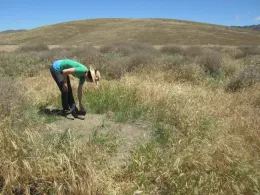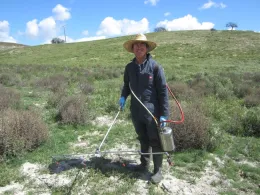Tackling Tumbleweed in San Benito County
Many of the ranchers I've spoken with over the last year and a half have said that tumbleweed, also known as Russian thistle (Salsola sp.), is a big problem in both San Benito and Monterey counties.
Local ranchers have said that tumbleweed is
- a much bigger problem in drought years and doesn't come up as much in wet years
- eaten by cattle when it is young
- a summer annual and is likely to be more wide-spread in areas that are not grazed in summer (because cattle aren't there to control it when it starts growing more quickly)
- more widespread in steep areas or other areas that are inaccessible to cattle
Since limited research has been conducted on control methods for tumbleweed, I partnered with Elise Gornish (UCCE Restoration Ecology Specialist at UC Davis),

We also installed a set of 3 plots to look at later-season herbicide spraying. This later herbicide treatment was done 5/27/2016, about 2 months after

Reference: Orloff, S. B.; D. W. Cudney; C. L. Elmore; and J. M. DiTomaso. Pest Notes: Russian Thistle UC ANR Publication 7486. UC Statewide IPM Program, University of California, Davis, CA 95616
